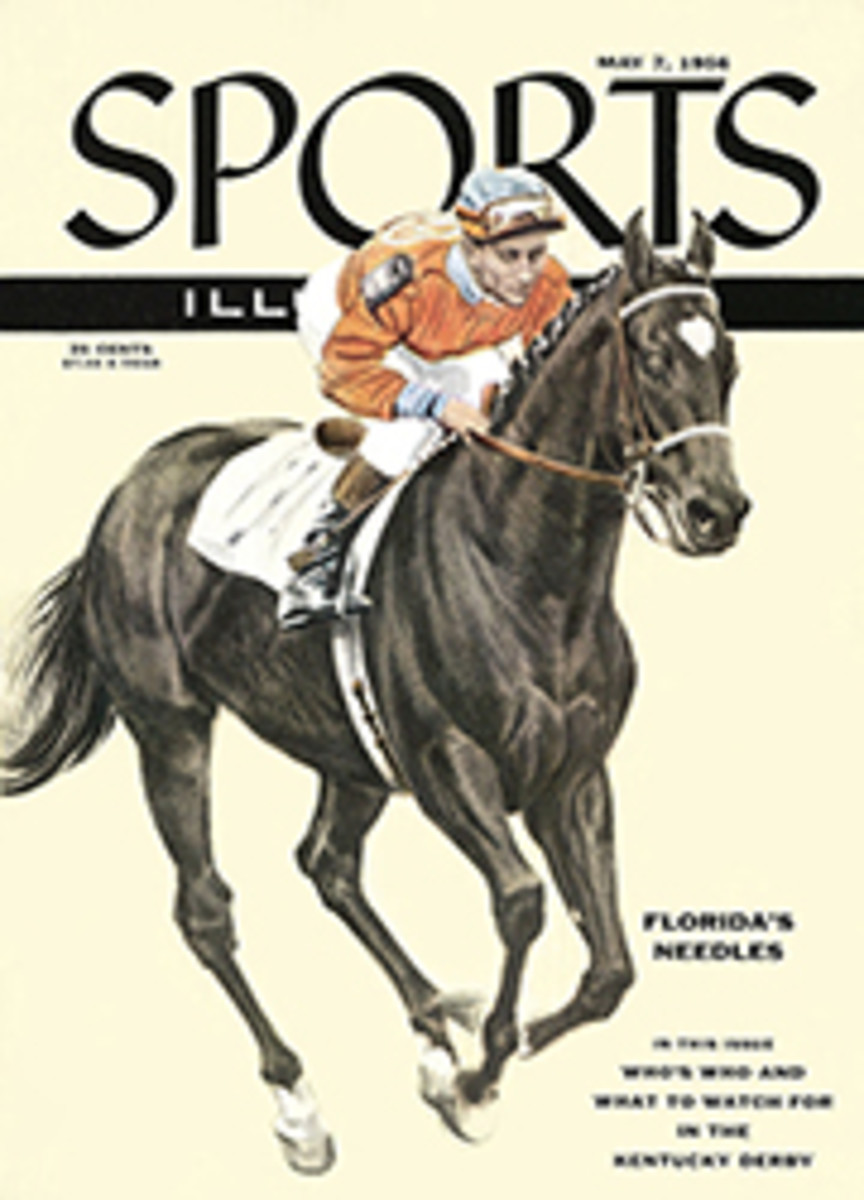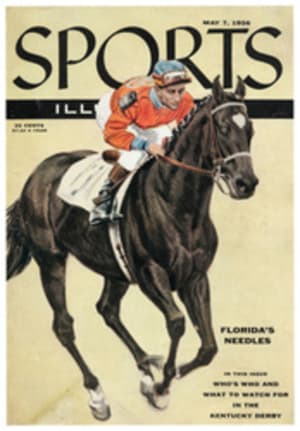
FIVE FERRARIS AND IL BELLO
The women of Italy called him Il Bello (The Beautiful One) and they crowded around him as he sat nonchalantly smoking on the tail of his 12-cylinder, 3.5 liter Ferrari at the starting line in Brescia. His white helmet sitting loosely on his jet-black hair, his tight-fitting blue jacket following every bulge of muscle on his young chest and shoulders, he looked indeed more like a movie idol than Italy's champion driver, co-winner with Juan Manuel Fangio of Florida's 12-hour Grand Prix of Endurance (SI, April 2) and best-beloved pupil of one of the greatest of the greats, the late Alberto Ascari. Yet for all of this, there were not many who would have bet on Eugenio Castellotti, the 25-year-old millionaire racer, to take first place in the tortuous Mille Miglia, the 1,000-mile grind around Italy which was now starting in the lowering dawn.
There was, for example, Fangio, champion of the world, with an identical Ferrari and a defeat in last year's Mille Miglia to spur him on. There was also Stirling Moss, the man who beat out Fangio a year ago and, with his potent if untried 3.5 Maserati, was a hot favorite to take the race again. There was Piero Taruffi in a 3-liter Maserati, a man never to be discounted; there were Luigi Musso and Peter Collins in their lively 4-cylinder, 3.5 Ferraris; there were the Mercedes 300 SLs, privately entered but with factory mechanics and equipment supporting them; and behind them the whole string of 365 cars, roaring off now one after the other at one-minute intervals toward Verona and the hazardous miles beyond.
There was, too, the racing strategy mapped out by Eraldo Sculatti, Ferrari's jovial manager, in which young Castellotti had his own allotted place. "The most important part for us," said Sculatti, "is the straight, fast stretch between Brescia and Pescara. It is easier to drive one of our cars at 100 miles per hour around bends than at 200 miles per hour on the straight." On this first half of the race Castellotti and Fangio, in the faster cars, would push hard; Musso and Collins, the second half of the Ferrari team, would save their strength, aiming to reach Rome still fresh and able to go all out over the rough and winding mountain passes of Radicofani, Futa and Raticosa. In this scheme of things, Castellotti did not have a position favorable for victory; his burning speed might take its toll of his car before the most rugged part of the race was reached.
According to plan, Castellotti hurled himself toward Verona at a 119-mph average. The rain-soaked roads kept his speed considerably below a record setting pace, but he was well ahead of the rest of the field when, like a modern Romeo, he roared into Juliet's city. First man behind was Taruffi, five mph slower, followed by Musso and Moss. Fangio, as at Sebring, was following his own inflexible plan, summed up by the motto: "The most important prerequisite of any race is to last through the race"—his pace was a modest 101 mph.
The rainy road curved south, then southeast again to the Adriatic Coast. Ravenna came and went—Il Bello was still leading, with Taruffi a scant 19 seconds behind. But now the sturdy Mercedes were creeping up. Wolfgang von Tripps in his 300 SL was only 58 seconds behind Castellotti. And then came the River Rubicon, Caesar's fateful crossing, fateful now to Piero Taruffi whose wet brakes failed. His Maserati left the road and in the crash its radiator cracked, ending the race for him.
Von Tripps in his Mercedes was a real threat now. Driving like an implacable demon, the German crept up second by second on the speeding Ferrari, and by the time Pesaro showed ahead, von Tripps was in the lead. Behind Castellotti, Fritz Riess in another 300 SL and Collins in his Ferrari fought neck and neck, followed by Musso, Fangio and Moss. But Castellotti had his orders to win before Pescara—if he could. As the field swept through Ancona, halfway through the coastal stretch, Il Bello was ahead again, leading the Mercedes by a few seconds. And this was the last chance that von Tripps was to have.
Pescara came and went, and then the German driver was out of it. Rather than ram a small car in front of him, von Tripps went off the road. But in his place, second to the fleeing Castellotti and seven minutes behind him, was the other Mercedes with Fritz Riess, fighting now to increase a one-minute lead over Collins' Ferrari. Four minutes behind Collins, running smoothly, came Fangio, leading Stirling Moss by three minutes. Thus the race stood at the halfway mark, with the roughest part of all still to go.
And it was Il Bello, Il Bello! from the throats of Roman girls as Castellotti, nine and a half minutes ahead of the field, flashed through the capital. The clocks showed 11:30 in the morning. Three people had died by that time, two drivers and a spectator, in three crashes; two more were to be killed and 16 injured before the day was out. The rain came down, and the race went on. Now Collins was behind the leader, three seconds ahead of Riess. The road spun up toward the mountain passes, and when Viterbo was reached Riess in his Mercedes had fallen back to fourth. Three Ferraris led the field: Castellotti, Collins and Musso, and Fangio was pressing the Mercedes hard, a scant minute behind. Stirling Moss was out of it, his Maserati having run off the road shortly after he passed Rome, and Radicofani, first of the mountain passes, lay ahead.
There was no stopping the Ferraris now. Collins and Musso, who had saved their cars for just this stretch, pushed them to the limit, and it was one, two, three, four for Ferrari when they flashed through Florence with Castellotti still maintaining his nine-and-a-half-minute lead. And then it was one, two, three, four, five when Olivier Gendebien in his Gran Turismo Ferrari overtook Riess in the Mercedes and moved into fifth place behind Fangio.
That was the order of finish when Eugenio Castellotti, drenched with rain, trousers matted to his legs, redeyed but triumphant, led an unprecedented Ferrari parade across the finish line at Brescia. It was 11 hours, 37 minutes and 11 seconds after he had left the same point in the same direction in the lowering dawn, and he had covered the distance in between at 85.40 miles per hour. It was a precious triumph to him: three times before he had started this race and three times he had failed. "He is always very impetuous," said his grinning race manager Sculatti. "This time the rain checked his impetuosity. Possibly this contributed to his final victory."
[originallink:10468226:42467]
PHOTO
HANDSOME AND RICH, CASTELLOTTI IS ITALY'S TOP DRIVER
PHOTO

